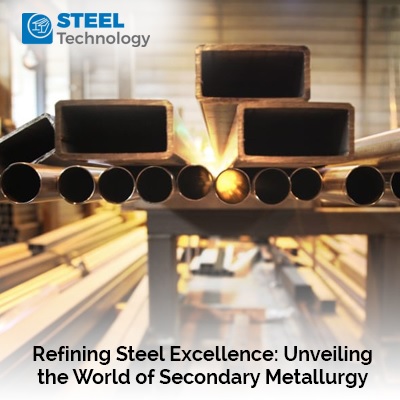Refining Steel Excellence: Unveiling the World of Secondary Metallurgy

Introduction to Secondary Metallurgy in Steel
Secondary metallurgy plays a crucial role in the steelmaking process, enhancing the quality, purity, and properties of steel to meet stringent industry standards and customer requirements. This advanced stage of steel refining occurs after primary steelmaking, where raw materials are converted into crude steel. Secondary metallurgy processes focus on refining and adjusting the chemical composition, temperature, and inclusion content of steel, ensuring it achieves the desired mechanical, thermal, and metallurgical properties.
I. Key Processes in Secondary Metallurgy
Ladle Refining: The first step in secondary metallurgy involves transferring the molten steel from the primary converter to a ladle for further treatment. Ladle refining processes include desulfurization, degassing, alloying, and temperature adjustments to refine the steel's composition and properties.
Vacuum Degassing: Vacuum degassing removes dissolved gases, such as hydrogen, nitrogen, and carbon monoxide, from the molten steel to improve its cleanliness, ductility, and mechanical properties. This process is crucial for producing high-quality steel grades for critical applications.
Alloying: Secondary metallurgy allows for precise alloying of steel with elements like chromium, nickel, manganese, molybdenum, and vanadium to enhance its strength, corrosion resistance, toughness, and other desired characteristics. Alloying also enables the production of specialized steel grades for specific industrial sectors, including automotive, aerospace, construction, and energy.
Desulfurization: Desulfurization processes aim to reduce sulfur content in steel to enhance its machinability, weldability, and resistance to hydrogen embrittlement. Techniques such as calcium treatment, magnesium injection, and fluxing agents effectively remove sulfur from the molten metal, ensuring the final steel product meets stringent quality standards.
Inclusion Control: Managing non-metallic inclusions is critical in secondary metallurgy to improve steel cleanliness and prevent defects like porosity, segregation, and brittleness. Inclusion control techniques involve the use of slag refining, inert gas bubbling, and synthetic slags to minimize inclusion content and enhance steel quality.
II. Benefits of Secondary Metallurgy
Enhanced Steel Quality: Secondary metallurgy processes refine steel composition, cleanliness, and properties, resulting in high-quality steel with improved mechanical, thermal, and metallurgical characteristics.
Customized Alloying: Alloying during secondary metallurgy allows for precise control over steel composition, enabling the production of customized steel grades tailored to specific industry requirements and applications.
Improved Performance: Clean, alloyed steel produced through secondary metallurgy exhibits superior performance in terms of strength, ductility, corrosion resistance, fatigue resistance, and weldability, meeting the demands of diverse end-users.
Consistent Product Quality: Secondary metallurgy ensures consistent product quality and compliance with international standards, enhancing customer satisfaction and market competitiveness for steel manufacturers.
III. Challenges and Innovations in Secondary Metallurgy
Process Optimization: Continuous process optimization is essential in secondary metallurgy to minimize energy consumption, reduce production costs, and enhance overall efficiency while maintaining product quality and performance.
Environmental Impact: Managing environmental impacts, such as emissions, waste generation, and resource utilization, is a significant challenge in secondary metallurgy. Innovations in clean technologies, recycling, and sustainable practices are key focus areas for the industry.
Inclusion Control: Achieving effective inclusion control remains a technical challenge in secondary metallurgy, requiring advanced analytical techniques, process monitoring, and quality control measures to ensure optimal steel cleanliness and performance.
Automation and Digitalization: The integration of automation, artificial intelligence, and data analytics in secondary metallurgy is driving efficiency, accuracy, and real-time process control, enabling steel manufacturers to optimize operations and quality management.
IV. Future Trends in Secondary Metallurgy
Advanced Materials Development: Continued research and development in secondary metallurgy will lead to the development of advanced materials with enhanced properties, including high-strength steels, lightweight alloys, and innovative composites for various industrial applications.
Industry 4.0 Integration: The adoption of Industry 4.0 technologies, such as IoT sensors, robotics, and predictive analytics, will revolutionize secondary metallurgy by enabling smart, connected factories with real-time monitoring, predictive maintenance, and data-driven decision-making.
Sustainability and Circular Economy: Steel manufacturers are increasingly focusing on sustainability, circular economy principles, and carbon-neutral production processes through renewable energy sources, waste valorization, and closed-loop material cycles to minimize environmental impact and maximize resource efficiency.
Conclusion
Secondary metallurgy is a vital stage in the steelmaking process, offering opportunities to refine steel quality, customize alloy compositions, improve performance, and meet evolving market demands. By addressing challenges, embracing innovations, and aligning with future trends, the steel industry can continue to enhance product quality, sustainability, and competitiveness in a dynamic global market landscape.











